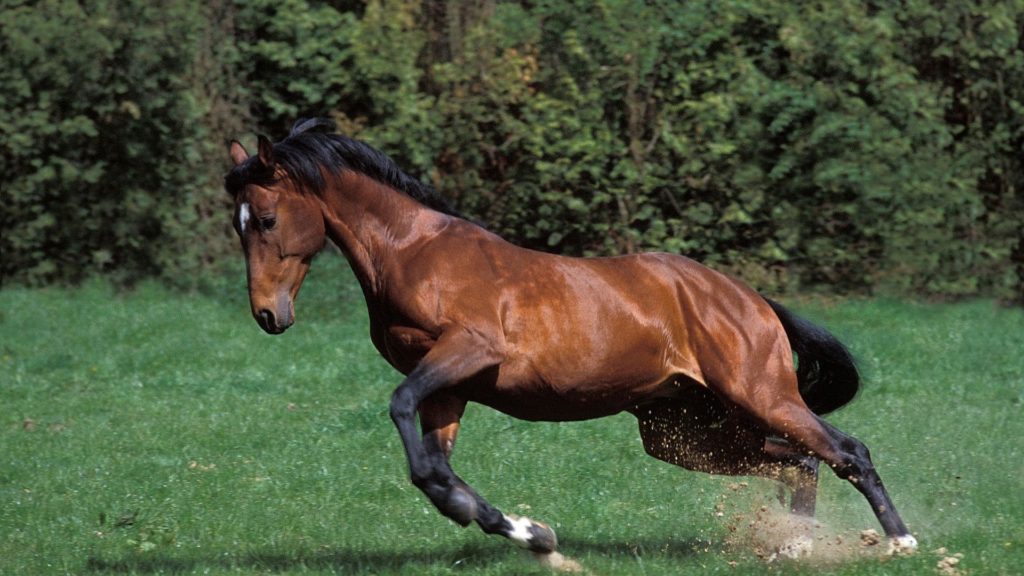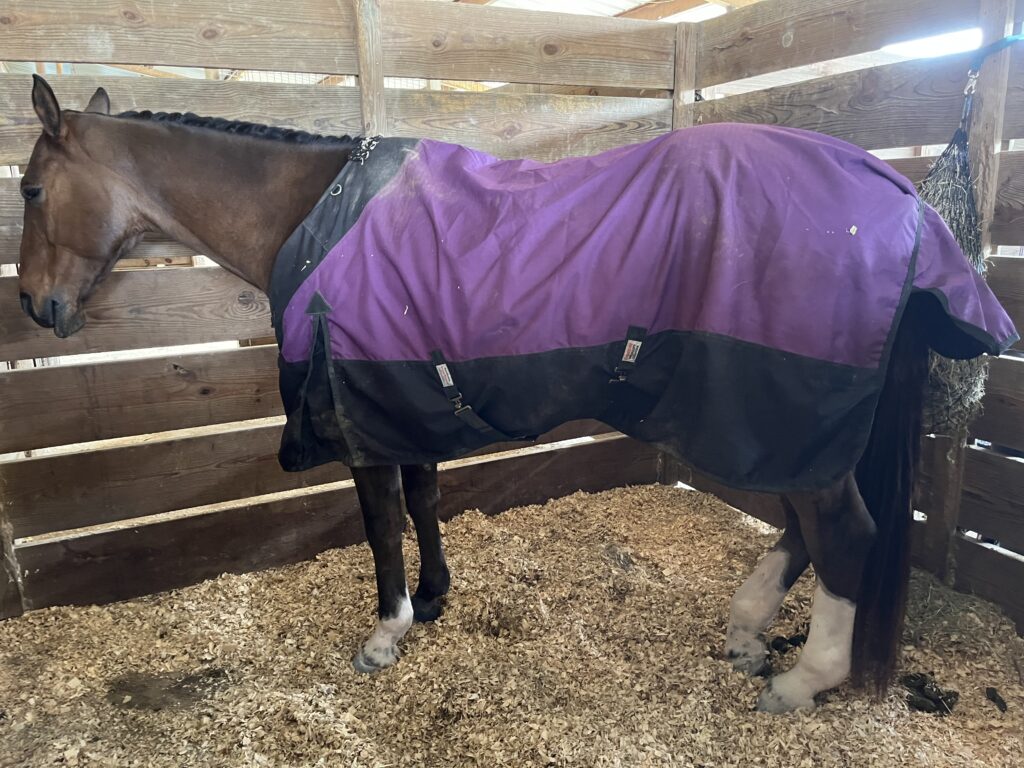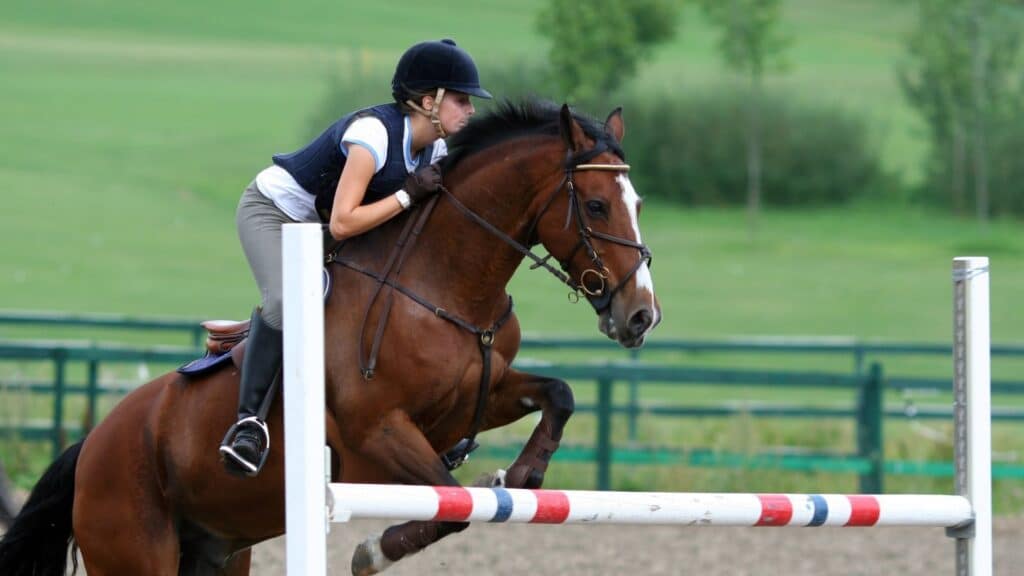Last updated: May 19, 2023
From the racetrack to the show ring, certain horse breeds consistently rise above the rest. Few, however, excel across the board, especially in disciplines as demanding as dressage and show jumping. My research leverages sport horse rankings and organizational data to pinpoint the top five breeds excelling in both these arenas.
The top echelons of dressage and show jumping are dominated by the Dutch Warmblood, Westphalian, Oldenburg, Selle Francais, and Irish Sport Horse. These breeds not only compete but consistently outperform others, establishing a legacy in both disciplines.
Interestingly, the qualities that make a horse an excellent jumper often translate into dressage success. A closer look at these high-performing breeds reveals a convergence of traits, temperament, and innate athletic ability key to their shared success across these equestrian sports.
This article is part of my series focused on horse breeds-I started by writing an introductory piece: Horse Breeds: The Ultimate Guide. The introduction to the series is a comprehensive overview of different breeds and types of horses.
1. Dutch Warmblood

Dutch warmbloods are bred to compete; they are true sport horses. Like most warmbloods, Dutch Warmbloods are not purebred horses in the typical sense, such as Arabians or Thoroughbreds.
Their registry is open to any breed. So long as the new blood’s introduction improves the horses’ performance in equine events, including dressage and jumping.
In reality, very few horse breeds aren’t a mixture of different bloodlines. However, most close their books to outside influence once the breed is established. For example, Thoroughbreds have a strict registry today but were developed with the influence of three Arabian stallions. The Dutch warmblood registry is still evolving and improving with new bloodlines.
The Dutch Warmblood breed is a mixture of German, French, and English bloodlines crossed with horses from the Netherlands. The two foundation Dutch breeds are Groningen and Gelderlander. Both breeds were primarily used for farming; however, they were transitioned to riding steeds with the advent of farming machines. The Groningen horse was stout, and the Gelderland lightweight. The horse’s body types are refined through years of selective breeding.
Temperament
Dutch Warmblood horses are famous for their character, intelligence, and calm demeanor. They work hard and are suitable for any level of rider. But these horses will accommodate when you need to step it up in competition.
Breed Characteristics
- Height: These horses average 1.62 hands but can reach 17 tall.
- Color: Coat colors include chestnut, bay, black, or gray, with white markings often on their face and legs.
- Physical Traits: Straight profiled face, well-muscled neck, straight long back, and a short croup. Deep chest with well-sloped shoulders. Powerful and highly muscled hindquarters.

Summary:
The Dutch Warmblood breed is a complete horse; its soundness and athletic ability make it the best choice for anyone seeking a top performer in dressage and jumping.
2. Westphalian

Westphalian or Westfalen horses are from the North Rhine region of northwestern Germany. They freely roamed the area as far back as 1 AD during the Roman excursion.
Throughout their history, the Westphalian uses and body has evolved. Selective breeding of the free-roaming horses focused on size; the region needed big-boned strong draft horses to work fields. So they introduced large European blood to the local horse population.
However, as machinery took over farming duties, the Westphalian duties as a farm horse became obsolete. So breeders began to focus on creating breeding for riding. Horse owners crossbred Westphalian horses with lighter horse breeds, such as Thoroughbreds and Hanoverians, to effectuate this desire.
Today, these warmbloods are built for sports eventing and pleasure riding and are the second most populous German horse breed. They are one of the best horse breeds in dressage and jumping.

Temperament
Westphalians have outstanding character and are willing workers; they learn quickly and are easily trained. Because of their easygoing nature, they are suitable for all levels of riders. However, keep in mind they are large athletic horses that enjoy moving.
Breed Characteristics
- Height: A typical Westphalian is between 15.2 and 17.2 hands tall.
- Color: Any color is accepted for registration; however, most Westphalians have solid black, bay, chestnut, or grey coat.
- Physical Traits: Westphalians have large, attractive heads and long, well-set necks. The animals have deep chests, sloping shoulders, straight back, and powerful hindquarters.
Summary:
The Westphalian breed is top-performing dressage and jumping horse. It is a warmblood breed from Germany with a temperament that works well at any competition level.
3. Oldenburg

The Oldenburg horse is another German breed from the northern area, once known as the kingdom of Oldenburg. The Oldenburg horse is one of Europe’s oldest warmblood breeds.
The breed’s development traces back to the 16th century and Herzog Anton Gunther von Oldenburg. He developed the breed by selectively breeding Friesian broodmares with stallions from Spain and Italy.
Oldenburg horses were used as carriage horses for centuries. However, the German Oldenburg breeding association in the 1960s decided to transform the Oldenburg carriage horse into a new lighter riding horse.
To effectuate this plan, they introduced many bloodlines, including Thoroughbred, Holsteiner, Trakehner, and Westfalians. The program was successful; modern Oldenburg horses are among the top sport-riding horse breeds globally.
Temperament
Oldenburgs are famous for their gentle character and intelligence. Just like other top-performing sports horses, they are willing workers and learn quickly.
Breed Characteristics
- Height: Oldenburgs typically stand between 16 and 16.3 hands
- Color: Most Oldenburgs have a solid coat color; although any color can be registered, the most common colors are bay, brown, or black.
- Physical Traits: Large frame, with a well-set long neck and long sloping shoulders. They have muscular legs, a strong back, and loin as a well-developed croup.
Summary:
The Oldenburg is a well-balanced horse that succeeds in both dressage and jumping. Their breeders have combined the bloodlines of many breeds to perfect this horse.
4. Selle Français

The Selle Francais is a French warmblood. Like other warmbloods, it is a mixture of various breeds. However, the inclusion of trotting breeds is unique about this warmblood breed.
Local French breeders in Normandy imported Thoroughbreds and Norfolk Trotters to cross with native horses. These crosses resulted in the foundation stock for the modern Selle Francais horse, the Anglo-Norman saddle horse. As with many other European horses, Selle Francais breeders began developing their horses for riding.
They emphasized speed, stamina, and athletic ability. The regional breeders organized their new breed and called it the French Saddle Horse or Selle Francais. This French horse breed is a top performer in dressage and jumping and competes in racing and eventing.
Temperament
Selle Français’ have the temperament needed to excel; they are willing to work, intelligent, and patient. They make an excellent mount for all levels of competitors.
Breed Characteristics
- Height: The Selle Francais has a wide range in their height; they can be as short as 15.2 hands all the way to 17 hands tall.
- Color: Like other warmbloods, any color is accepted for registration; however, most Selle Francais is chestnut.
- Physical Traits: Like their height, their bodies vary, but generally, they have a deep chest, sloping shoulders, and a long muscular body.
Summary:
This French warmblood is a mixture of many breeds. The combinations worked to produce an extremely athletic horse and one with a superior temperament and sound body. This animal is a perfect animal for dressage and jumping.
5. Irish Sport Horse

Irish Sport Horses are a versatile breed that excels at dressage and jumping. They are a combination of Irish Draught Horse and Thoroughbreds. According to the FEI, the preferred percentage is three-quarters Thoroughbred blood with one-quarter Irish Draught.
These warmbloods get their strength and size from the Irish Draught side while gaining speed, athleticism, and refinement from the Thoroughbred bloodlines.
The combination produced a calm, sensible horse with desire, speed, and athletic ability. Irish Sport horses are durable, sound, and have the stamina to excel in assorted equine activities.

Temperament
Irish Sport horses have an easy-going disposition and are smart and willing workers. They can be used at all riding levels and make good horses for beginning riders. However, some express their Thoroughbred bloodlines and are a little high-strung.
Breed Characteristics
- Height: The height of Irish Sport horses varies greatly depending on their cross, but they typically stand between 15 and 17 hands tall.
- Color: Any color is acceptable for registration, even paints. However, Irish Sport horses’ most common coat colors are grey, chestnut, bay, and black.
- Physical Traits: Irish Sport horses should have long sloping shoulders with a deep chest and a short compact back, muscular croup, and strong hindquarters.
Summary:
Irish Sport horses are great all-around athletes that excel in dressage and jumping. Most are calm and make good horses for all levels of riders.

What Traits Do Good Dressage and Jumping Horse Share?
When you look at top performers, there is variety; some are tall and lean, and others are quite compact and muscular. If there is one common thread, it’s correct conformation.
Conformation generally refers to the overall balance and structure of a horse’s bones and muscles. Horses with correct conformation have fewer injuries and perform better.
When breeders recognize common conformational traits in top performers, they try to duplicate these attributes in their future foals. For example, if most top-performing horses have long sloping shoulders and short pasterns, breeders will try to replicate this.
Solid pedigrees, many of the top performers are from exceptional bloodlines. Although horses make it to the top levels of dressage and jumping competitions without popular pedigrees, it is unusual.
Breeding dressage and jumpers is big business and can be lucrative for those raising elite horses. World-class yearlings sell for close to $50,000, and those in training often sell for much higher.
Good character may be the most critical factor for success in top-performing dressage and jumping horses. Some people may call it temperament instead of character, but regardless, I’m referring to the animal’s attitude.
To be the best at any equine event takes hours, days, and years of training with your horse. And your horse must have the ability to learn, be willing to work, and have a competitive spirit. One that doesn’t back down from a challenge and thrives on getting better are the characteristics they need to succeed.
And finally, you have to have a horse with physical ability. The top-performing jumping horses are athletic, strong, and explosive but remain in control. These animals bring all these traits together to succeed.
Think about human athletic competition; it’s not always the biggest or strongest person who wins; often, you’ll see less impressive ones dominate the competition. The same happens in dressage and jumping events.
It’s not all about size and conformation; a horse needs coordination and a work ethic as well.
The Best Dressage and Jumping Horse Breeds.
| Breed | Jumping Rankings | Dressage Rankings | Eventing\ Rankings | Overall |
|---|---|---|---|---|
| Dutch Warmblood | #1 | #1 | #3 | First |
| Westphalian | #2 | #3 | Intermediate | Second |
| Oldenburg | #6 | #4 | #6 | Third |
| Selle Français | #5 | Intermediate | #5 | Fourth |
| Irish Sport Horse | Intermediate | Intermediate | #1 | Fifth |
To choose the horse breeds in my list of best dressage and jumping horses, I considered the current rankings in the Federal Equine International (FEI), reviewed the ranking in the World Breeding Federation for Sports Horses (WBFSH), and considered the success of the breed historically.
Of course, my list is subjective, and there can be an intelligent argument for including some other breeds. However, I wanted to keep the list to the five most dominant horse breeds in dressage and jumping.
Here is a comparison table with some general information about the conformation, price, and temperament of these horse breeds:
| Breed | Conformation | Price | Temperament |
|---|---|---|---|
| Dutch Warmblood | Athletic, balanced | Moderate to high | Even-tempered, willing |
| Westphalian | Athletic, balanced | Moderate | Intelligent, willing |
| Oldenburg | Athletic, balanced | Moderate to high | Intelligent, willing |
| Selle Français | Athletic, balanced | Moderate to high | Intelligent, willing |
| Irish Sport Horse | Athletic, balanced | Moderate | Intelligent, willing |
It’s important to note that these are generalizations, and individual horses within a breed may vary in conformation, price, and temperament. It’s also worth noting that factors such as age, training, and breeding can also affect a horse’s conformation, price, and temperament.
Below is a YouTube video that discusses the best horse breeds for dressage.
Conclusion
In the world of dressage and show jumping, breed plays a significant role, but it’s not the only factor to consider. Dutch Warmblood, Westphalian, Oldenburg, Selle Francais, and Irish Sport Horse have proven themselves time and again to be the top contenders, demonstrating the physical prowess and temperament needed for these demanding disciplines.
However, equally vital is the commitment to quality training and empathetic handling, which helps unlock a horse’s potential, regardless of its breed. The beauty of these equestrian sports lies not just in the horse’s performance but also in the bond between horse and rider, formed through countless hours of training and understanding.
Remember, whether you’re an aspiring equestrian or a seasoned rider, the journey in equestrian sports is just as important as the destination. So, saddle up, trust your horse, and let the adventure unfold.
Related articles:
- Is Dressage Cruel to Horses? the Sport and Training Examined
- Thoroughbred Horse Breed: Facts, Height, and Characteristics
- Are Andalusian Horses Warmbloods, Fast, or Good Jumpers?
- What Are Friesian Horses Used For? 5 Uses That May Surprise!
- War Horses: Discovering the Unique Breeds Used in Battle
- Discovering the Andalusian Horse: Facts and Characteristics
- Friesian Horse Facts, Temperament, and Breed Characteristics

About the Author: Miles Henry
Lifelong Horseman | Racehorse Owner | Published Author
Miles Henry brings over 25 years of hands-on experience training and owning Thoroughbred racehorses. Raised with Quarter Horses and Appaloosas, he’s spent a lifetime learning from horses—on the track, in the barn, and in the field. Today, he runs a small but successful racing stable in Louisiana and shares real-world insights on HorseRacingSense.com, helping horse owners, fans, and bettors navigate the sport with confidence.
📚 Books: View Miles’s books on Amazon »
🎧 Podcast Guest: Animal Tales Ep. 32 |
YouTube Interview
📩 Newsletter: Sign up for racing tips and horse care advice »
🔗 Follow Miles:
Twitter |
Facebook |
YouTube


